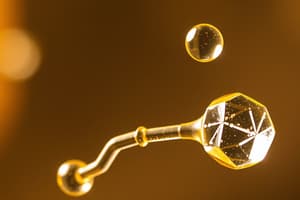Podcast
Questions and Answers
What is the unique phenomenon of regulating iron absorption referred to as?
What is the unique phenomenon of regulating iron absorption referred to as?
mucosal block theory
What induces hepcidin mRNA transcription via the BMP/SMAD signaling cascade?
What induces hepcidin mRNA transcription via the BMP/SMAD signaling cascade?
- High serum iron levels (correct)
- Inflammatory cytokines
- High erythropoietic drive
- All of the above
Calcium inhibits iron absorption in both rats and humans.
Calcium inhibits iron absorption in both rats and humans.
True (A)
Beta-carotene is converted to retinal by 15,15`-mono-oxygenase, and then to retinol by retinol ___________.
Beta-carotene is converted to retinal by 15,15`-mono-oxygenase, and then to retinol by retinol ___________.
What is the biologically active form of Vitamin B1?
What is the biologically active form of Vitamin B1?
Which neurotransmitter is synthesized with the help of TPP?
Which neurotransmitter is synthesized with the help of TPP?
Thiamine is involved in energy production and nutrient metabolism.
Thiamine is involved in energy production and nutrient metabolism.
FAD is a coenzyme that plays a role in ________ metabolism.
FAD is a coenzyme that plays a role in ________ metabolism.
Match the following B vitamins with their major coenzyme forms:
Match the following B vitamins with their major coenzyme forms:
Flashcards are hidden until you start studying
Study Notes
Vitamin B Complex and Energy Metabolism
- Vitamin B1 (Thiamine):
- Biological active form: Thiamine Pyrophosphate (TPP)
- Involved in energy production and nutrient metabolism
- Required for the synthesis of acetyl choline, a neurotransmitter
- Plays a role in glycolysis, conversion of pyruvate to acetyl CoA, and the Krebs cycle
- Also involved in peroxisomal fatty acid degradation
- Vitamin B2 (Riboflavin):
- Coenzyme forms: Flavin Mononucleotide (FMN) and Flavin Adenine Dinucleotide (FAD)
- Involved in energy metabolism and catalyzes redox reactions
- FAD-dependent enzymes: PDH, KGDH, Succinate dehydrogenase, and Kynurenine 3-Monooxygenase
- Vitamin B3 (Niacin):
- Coenzyme forms: Nicotinamide Adenine Dinucleotide (NAD) and Nicotinamide Adenine Dinucleotide Phosphate (NADP)
- Involved in energy metabolism, glycolysis, and the citric acid cycle
- Vitamin B5 (Pantothenic acid):
- Precursor to Coenzyme A (CoA)
- CoA is involved in energy metabolism, fatty acid synthesis, and the citric acid cycle
- Vitamin B6 (Pyridoxine):
- Coenzyme form: Pyridoxal Phosphate (PLP)
- Involved in amino acid, glucose, and lipid metabolism
- Required for the synthesis of catecholamines, heme, and NAD
- Vitamin B7 (Biotin):
- Coenzyme form: Biotin
- Involved in fatty acid synthesis, gluconeogenesis, and amino acid metabolism
- Vitamin B9 (Folic acid):
- Coenzyme form: Tetrahydrofolate (THF)
- Involved in one-carbon metabolism, amino acid synthesis, and nucleotide synthesis
- Vitamin B12 (Cyanocobalamine):
- Coenzyme form: Adenosylcobalamin
- Involved in the conversion of L-Methyl Malonyl CoA to Succinyl CoA
Vitamin A and Zinc
- Vitamin A:
- Involved in the visual cycle, gene transcription, and cell differentiation
- Zinc is essential for the absorption and utilization of vitamin A
- Deficiency in vitamin A leads to impaired vision and immune function
- Zinc:
- Involved in the absorption and utilization of vitamin A
- Plays a role in the normal functioning of the immune system
- Essential for the activity of many enzymes and proteins
Iron and Protein
- Iron:
- Has two oxidation states: ferrous (Fe2+) and ferric (Fe3+)
- Essential for the function of many enzymes and proteins
- Involved in energy metabolism, particularly in the citric acid cycle
- Regulation of iron absorption is crucial to prevent toxicity
- Protein:
- Involved in the transport of iron in the body
- Hepcidin, a protein produced in the liver, regulates iron absorption
- DMT1, a protein located on the surface of enterocytes, facilitates the uptake of iron
Interrelation between Fat and Vitamins A, D, E, and K
- Vitamin A:
- Absorbed in the intestines with the help of bile salts
- Transported to the liver via chylomicrons
- Stored in the liver and adipose tissue
- Vitamin D:
- Absorbed in the intestines with the help of bile salts
- Transported to the liver via chylomicrons
- Stored in the liver and adipose tissue
- Vitamin E:
- Absorbed in the intestines with the help of bile salts
- Transported to the liver via chylomicrons
- Stored in the adipose tissue
- Vitamin K:
- Absorbed in the intestines with the help of bile salts
- Transported to the liver via chylomicrons
- Stored in the liver and adipose tissue
Studying That Suits You
Use AI to generate personalized quizzes and flashcards to suit your learning preferences.




